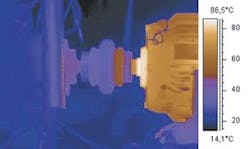Infra-red thermography enhancements improve scale formation control
As the market for infra-red (IR) thermography grows, the cost of equipment is dropping, even though the technology is becoming more sophisticated. These developments enhance the benefits this technology has to offer the offshore industry, particularly in the fields of preventive and predictive maintenance, says Björn Schmidt, sales director for FLIR Systems.
The company, based in Sweden, is the center for civilian applications of IR thermography for the FLIR Systems group, which is headquartered in the US. Last year, through its merger with Indigo Systems, a leading detector manufacturer, FLIR became the most vertically integrated IR camera manufacturer. All hardware and software for the equipment is developed in-house, where all critical components are also manufactured.
It is exactly 40 years since FLIR’s predecessor AGA/Bofors sold its first IR camera for industrial use and power line inspection. The technology has since developed into a powerful inspection tool with applications across most of industry. IR cameras detect infrared radiation invisible to the human eye, but which shows the temperature distribution in the object under inspection.
Temperature distribution as shown in an infrared image can reveal a malfunction, as in this overheated motor axle.
Given knowledge of the temperature distribution pattern associated with normal functioning, the IR image can give an immediate indication of an abnormality. In an offshore context, the technology can be used to inspect a wide range of equipment, including rotating machinery, electrical installations, heat exchangers, steam traps, tanks, and insulations, Schmidt says. It cannot see through shielding materials, but it can detect malfunctions in the shielded equipment through abnormalities in the temperature distribution on the shielding materials.
Detecting scale
Using IR thermography, a Norwegian offshore maintenance contractor detected and monitored scale formation inside production pipes where other methods such as ultrasonic and x-ray inspection had failed. IR inspection provided the basis for controlling scale formation and avoiding the expense of shutting down production to remove the scale.
FLIR’s latest cameras are extremely sensitive, detecting temperature differences as low as 0.08° C. The company has put a lot of effort into developing the user/camera interface and making the camera easy to operate, Schmidt says. For example, the display can be separated from the camera to facilitate deployment in confined spaces, images can be saved with accompanying voice comments for later analysis, and a TV camera is built in to provide visual images of the objects under inspection.
All FLIR cameras are tailor-made to the customer’s specifications. However, despite their growing sophistication, their cost is falling. FLIR’s offshore customers include Statoil, ConocoPhillips, Shell, and seismic contractor PGS in the Norwegian sector.
For more information, contact Björn Schmidt, FLIR Systems. Tel +46 8753 2750, fax +46 8755 0752, [email protected], www.flir.com.






